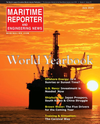
Page 12: of Maritime Reporter Magazine (June 2016)
Annual World Yearbook
Read this page in Pdf, Flash or Html5 edition of June 2016 Maritime Reporter Magazine
MARKET INSIGHT: JAPAN
Photo: Maritime Reporter & Engineering News
Japan Powers Ahead
Japanese shipbuilding’s focus on pro? tability, not volume, pays off as its order books are full while others fail
BY GREG TRAUTHWEIN
On a recent visit to Tokyo, Maritime Reporter & Engineering News had the opportunity to visit with Hiroaki Sakashita,
Director-General, Maritime Bureau, of Japan’s Ministry of Land, Infrastructure, Transport and Tourism (MLIT) Mr.
Sakashita shared his insights on major trends and drivers today in Japan’s shipping, shipbuilding and seafarer sectors.
For our readers not familiar with two agencies responsible for maritime Japan is one of the major shipping building industry in Japan to go through yourself and your of? ces, could you issues are Port and Harbor Bureau and and shipbuilding nations in the world. a drastic structural adjustment. During describe to me your position and the Maritime Safety Agency (Japan Coast It is an island nation surrounded by sea, periods of increasing demand, South
Guard). Meteorological Agency, which and shipping and shipbuilding indus- Korea in 1990s and China in 2000s overall responsibility of this of? ce?
provides marine weather services, is also tries have played an important role in rapidly built up their shipbuilding ca-
The Maritime Bureau was established under the jurisdiction of MLIT, Ministry the development of its economy and the pacity, while Japanese shipbuilders, of Land, Infrastructure, Transport and nation’s growth. I think Japan is quite learned through hard experience, opted by consolidating three bureaus: the Ship- ping Bureau; the Ship Bureau, which Tourism. Thus all marine related admin- unique as a maritime nation, where all to enhance capacity not by building up istrative affairs fall under the jurisdiction the three components necessary for the physical capacity but through improving was in charge of shipbuilding and tech- of MLIT except for ? shery. development of robust maritime in- productivity. nology development for ships; and Sea- dustry: shipping, shipbuilding and ship In other words, having experienced farer’s Bureau. As such the Maritime
Bureau is in charge of shipping industry, I would like to ? rst discuss shipbuild- machinery industry that supports them, the structural adjustment, Japanese ship- shipbuilding industry and issues involv- ing. Can you provide to me an over- have been fully developed through the builders have refrained from quantita- ing seafarers, who support maritime view of the shipbuilding business in history. In the past, from 1956 to almost tive expansion of building capacity and 2000, Japan used to have a market share rather focused on increasing pro? tabil- industry as human resources. We are Japan today? Speci? cally I’m inter- responsible for maritime safety and ma- ested to know the government policy of about half of the global shipbuilding. ity. In the light of current world ship-
In the wake of oil crises (of 1973), the building and shipping market condition rine environmental protection as well as regarding shipbuilding’s future.
global overcapacity forced the ship- plagued by oversupply, it has turned out maritime industry policy making. Other 12 Maritime Reporter & Engineering News • JUNE 2016
MR #6 (10-17).indd 12 6/6/2016 12:19:14 PM

 11
11

 13
13
